Civilization 6 ’s latest expansion, Rise and Fall, has made Civ more personal and yet more global than ever before. The new History Timeline feature memorializes your civilization’s moments of glory, from meeting tribal villages and clearing a barbarian outpost to building a bustling district or achieving a populated city.
These notifications are by far my favorite feature introduced in the new expansion: each game is its own story, filled with the zeniths of Heroic and Golden Ages and the nadir of Dark Ages, populated by a slate of governors with powerful abilities that can be utilized differently in every game. The new Loyalty mechanic is inspired: your citizens’ happiness, religion and proximity to one another all affect how much Loyalty they produce, which can result in a bloodless victory as weaker civs cede distant cities to your glory.
But Rise and Fall makes sure you don’t forget that your civilization marches in lockstep with a world community. The whole world moves through eras together. Emergencies, such as converting a holy city to another religion, conquering a city-state or dropping nukes, call upon the global community to take action.
Then there are alliances, which can last for ages with increasing yields depending on the length of alliance. Alliances are also more concrete in Rise and Fall: an economic alliance is suitable for almost any victory type, but all have their place.
So let’s take a look at the first game I played in Civilization 6 Rise and Fall: a religious victory from Tamar of Georgia.
Tamar immediately cleared barbarian outposts, explored the neighborhood and founded a religion, which took up most of her Ancient Era.
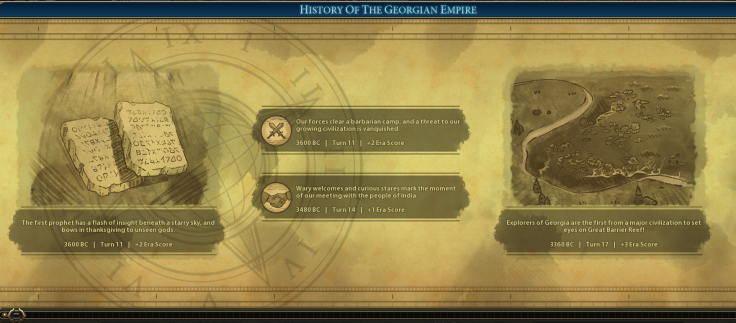
Without many achievements to speak of, Tamar’s Classical Era was a Normal Age. But that’s when her activity ramped up. She founded Zoroastrianism, founded a city near a World Wonder and became Suzerain of Bandar Brunei. She built the Temple of Artemis and the Oracle, cleared a nearby barbarian camp in a punishing show of strength and declared Autocracy as her first Tier 1 Government.
These achievements caused the nearby Egyptian city of Shedet to join the glorious Georgian civilization and propelled Georgia into a Golden Medieval Age.
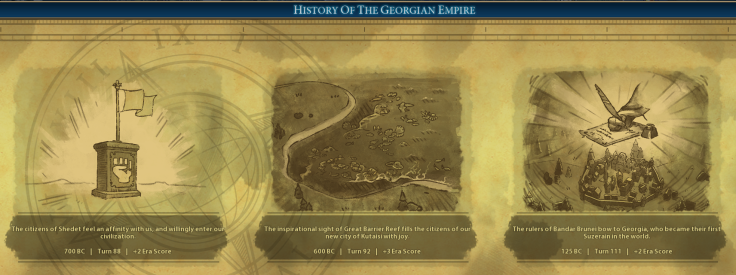
Georgia’s early achievements prompted a declaration of war from a neighbor: good ol’ Teddy Roosevelt of America. Thus, Georgia spent most of the Medieval Era conquering America. Washington was absorbed into the mighty Georgian Empire, which continued to grow and flourish.
But the Medieval Era’s bar for a Golden Age was higher than the Classical Era, and achievements such as a four-promotion Swordsman, the Suzerainty of Mohenjo-Daro, and a scattering of Great Generals weren’t quite enough to propel Tamar into a Golden Renaissance Era Age.
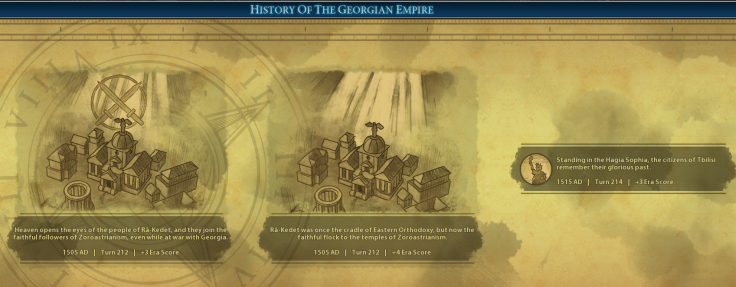
Now, Tamar found herself at war with Egypt, another bordering Civ jealous of her accomplishments. The city of Nekhen bloodlessly gave itself over to Georgia, but when Cleopatra declared war, Tamar did what she does best: convert and conquer.
The civilization of India to the south, led by Chandragupta, kept sending pesky missionaries, so Tamar converted their holy city as well. A scattering of Great People and a few Wonders from bygone eras later, Tamar of Georgia entered a Golden Industrial Era Age.
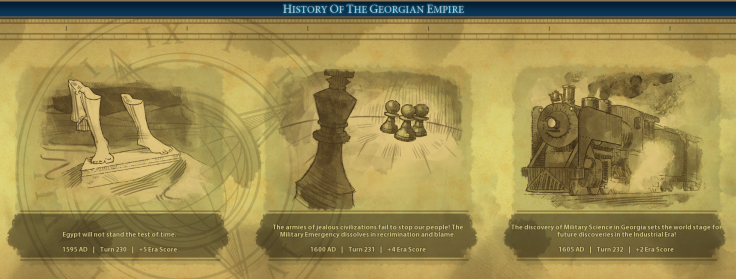
Tamar was a busy, busy bee during the Industrial Era, with both Religious and Military emergencies declared against her. Of course, she triumphed, and Egypt became nothing more than a myth. (In her kindness, she suffered America to live in a few cramped hexes by a tundra-tastic coastline.)
With the new Cassus Belli, Tamar declared a Golden Age war against India, who was a perennial thorn in her side. She converted and conquered more of India’s cities and rounded out her slate of advisors in order to maintain the loyalty of her wide-ranging empire, and circumnavigated the globe. Her accomplishments led her to a Golden Modern Era Age.
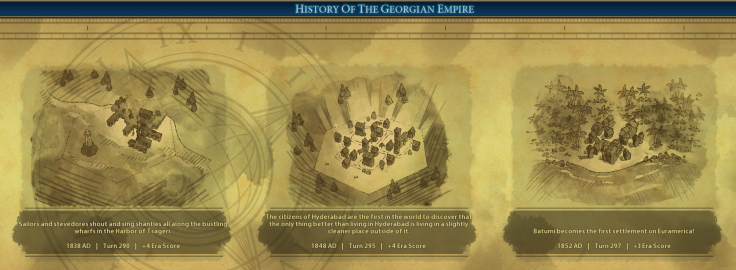
The Modern Age was one of building for Tamar of Georgia. Harbors, Neighborhoods, Commercial Hubs and even a new city on a new continent all brought new challenges for Tamar. France was less than pleased with their new neighbor and declared war, but heaven has a way of rewarding the righteous.

Tamar entered yet another Golden Age in the Atomic Era and defeated yet another Religious Emergency triggered by the conversion of Paris.
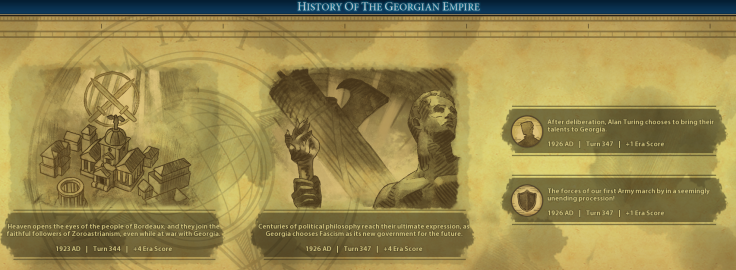
But war on two fronts began to drag on even the mighty Georgian empire as the jealous Aztecs, who greedily owned a whole continent all to themselves, declared a pointless war across the sea that neither party had the weapons to effectively fight.
Despite defeating a Religious Emergency (yes, again) triggered by the conversion of Geneva, birthplace of Shinto, Tamar of Georgia entered a Dark Age in the Information Era.
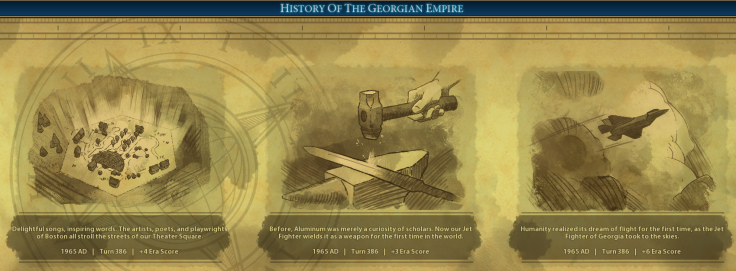
Tamar declared peace with Catherine of France, but the Dark Age penalties to Loyalty meant that even Georgia couldn’t hold onto Paris for long. It bounced back and forth between being a Free City and being conquered by Georgian military might, as Tamar couldn’t bear to see Paris go back to a scheming conniver like Catherine.
Worse, the Mongolians declared war on Tamar, too. But all this warring couldn’t deter Tamar from her true mission: bringing Zoroastrianism to the whole world. City after Mongolian city woke to the true faith, and Tamar ultimately won a Religious Victory. You go, girl!

The late game in Civilization 6 still chugs and drags: flight units remain far more work and trouble than they’re worth, especially in a wide empire where you need quite a few of them to make a difference.
The endless warring in the Tale of Tamar was unintentional and meant I didn’t have much chance to explore Alliances. It doesn’t seem to matter whether or not a war is declared on you, or you declare the war: either way, you are punished with a ruined reputation that will never, ever recover unless you return a city to its founder. (This option presented itself a few times with Paris, but hell no.)
Luckily, even in constant warfare, you can still come out in a Golden Age. However, since the Information Era is the last Era in the game, I must ask: is there no way out of an Information Era Dark Age? Say it ain’t so. I can take or leave the Emergencies (though the spoils for coming out on the right side of an Emergency are fantastic), but the loyalty mechanic, Historic Moments and Dedications are all great fun.
Overall, Rise and Fall doesn’t address any particular issues in early, late or mid-game, so any problems you have with those points in the game remain. Instead, Rise and Fall adds a framework to your game that makes it more comprehensible and more your own than ever before.



















